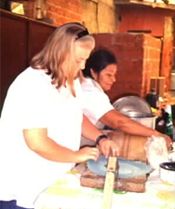

In the central valley of the Mexican state of Oaxaca, two miles down a dirt road from the main highway, the town of San Pedro is home to about 1700 people (1990 census). This community already bustled with some 3000 residents when the Spanish first arrived in Oaxaca during the sixteenth century.
If a few of those sixteenth century people could somehow re-appear in San Pedro today, they would surely be impressed by modern machines and contrivances. But after the future-shock, they might also be struck by another curious fact of modern life here: an evident imbalance in the sexes. Far more women than men live in the community.
In San Pedro, and eleven communities of the central valley, NSF-funded anthropologist Martha W. Rees, of Agnes Scott College, has been conducting a long-term study of the effects of Mexican migration to the United States. This is a migration study with an important twist: it concentrates not on those who actually migrate, most of whom are men, but rather on the women who remain behind, focusing on how they live, work, and survive.
Migration to the United States to find work became a particularly common pattern in this area, and much of Mexico, beginning with the crises of the 1980s. In fact, migration from the central valley of Oaxaca is intense -- one of the highest rates in Mexico. But to support an entire family in the United States is costly. This appears to be the reason why mainly men migrate. Most men try to send a significant part of their US income home, and many return to the valley and to their families for part of each year.
Rees has found that migrating men often report that the money they send home from jobs in the United States is all their wives and families need to live. But her interviews with women in the community reveal, on the contrary, that interruptions or shortages in money from the men abroad are common, and few of the women can depend entirely on income from migrant husbands. In fact, the women not only work at a variety of jobs in order to make ends meet, they also often must juggle a range of other work responsibilities, from maintaining fields of crops to managing exchange-rate-sensitive currency. While women in the valley have always worked in their households and helped with crops in the fields, male migration has led large numbers of women to work at jobs that range from making and selling tortillas, to buying vegetables from farmers and selling them in city markets, to embroidering or assembling dresses for export or sale to the tourist trade.
In a new phase of her studies, funded jointly by the NSF/SBE International and Anthropology programs, Rees expanded her research. Along with Mexican research associates Dolores Coronel Ortiz and Isabel Pérez-Vargas, Rees surveyed about 400 women in 11 communities. A small group of American undergraduates working with the researchers will benefit from hands-on field training in anthropological research methods - Danyael Miller (99), Michelle Patterson (99), Shaunda Blackwell (99), Vishwannie Persaud (00), Kelly Taylor (00), Shawn McClain (01) and Iyonka Strawn (99). Data from this study range from charting kinship relationships in extended families to collecting data about how women generate and manage income. The kinship charts include detailed information about migration and women's work patterns in entire extended families. The expanded project also allows the researchers to test a series of hypotheses: that, as assumed, men actually do migrate alone because migrant wages are too low to support accompanying families; that the patterns of male migration can endure because women work and support the household in the meantime; and that migration patterns are linked directly to local economic conditions.
"Every year more Mexicans migrate to the United States," notes Rees. "We in the United States need to know more about the larger picture the Mexican migrants are involved in. Why do they migrate? What is the effect on their lives at home?" As the numbers of Mexican migrant workers have increased in the US, their work has become increasingly important, if sometimes controversial, both economically and socially in both nations. These studies should shed new light on a long-ignored and little-known side of the international migration phenomenon.
For more information please see:
|
This research is partially supported by the Division of International Programs. |

 Roadsign: "Oaxaca is your home, come back soon"
Roadsign: "Oaxaca is your home, come back soon" Michelle Patterson (ASC 99) learns to make tortillas.
Michelle Patterson (ASC 99) learns to make tortillas. Doña Mari teaches Danyael Miller (ASC 99) to make tortillas.
Doña Mari teaches Danyael Miller (ASC 99) to make tortillas. Isabel Pérez-Vargas (Mexican research associate) and Danyael Miller (ASC 99) in the throes of field work in Oaxaca.
Isabel Pérez-Vargas (Mexican research associate) and Danyael Miller (ASC 99) in the throes of field work in Oaxaca."We in the US may think that we are very sophisticated, eating ethnic food in restaurants that have sprung up everywhere. But think about the worldliness of the Mexicans: in order to keep body and soul together, they must hop a train or a plane to find work, negotiate life and work far from home and in a foreign language, and often endure unfavorable conditions. Meanwhile, their wives plant, work, raise a family, open bank accounts and keep up with the peso/dollar exchange rate every day. How many of us do that?" Martha W. Rees, Anthropologist. All photos courtesy of Martha W. Rees |